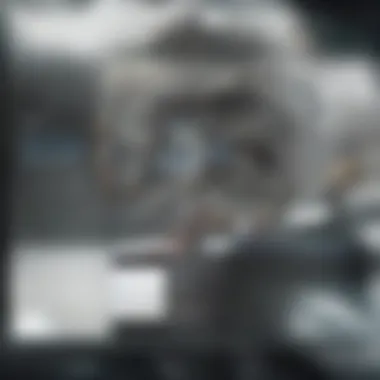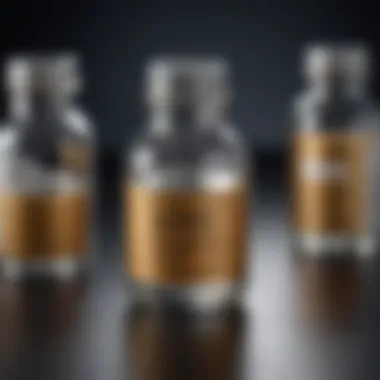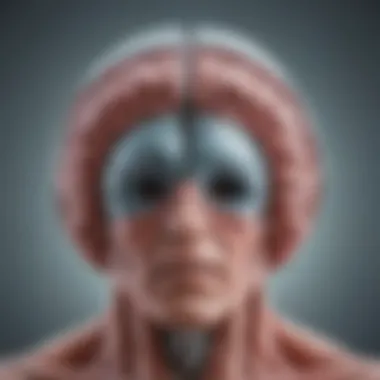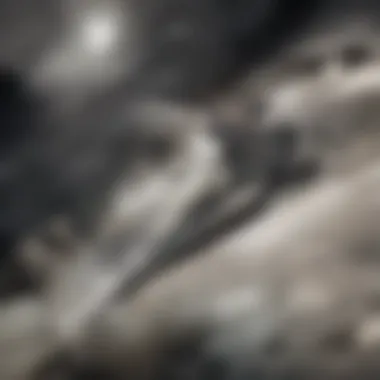MRI with Gadolinium: Process, Benefits, and Risks


Intro
Magnetic Resonance Imaging (MRI) serves as a pivotal tool in contemporary medical diagnostics. Among the various enhancements for MRI, gadolinium-based contrast agents hold a considerable significance. Understanding the application of gadolinium in MRI can illuminate the nature of this process, as well as the potential implications regarding benefits and risks. This narrative aims to demystify the essentials of gadolinium-enhanced MRI, enriching readers with the knowledge necessary to navigate this complex subject.
Background and Context
Overview of the Research Topic
The role of gadolinium in MRI is fundamentally linked to its properties as a contrast agent. When introduced into the body, gadolinium alters the magnetic properties of nearby water molecules, effectively enhancing the contrast of images obtained via MRI. This alteration aids in visualizing various tissues and organs, allowing for a deeper understanding of individuals' health issues.
Historical Significance
Historically, MRI advancements have paralleled the development of different contrast agents. Initially, MRI was limited by inferior contrast resolution. The introduction of gadolinium represents a notable shift, enhancing image clarity and enabling new diagnostic possibilities. Over recent decades, the use of gadolinium has become increasingly common, significantly influencing diagnostic imaging protocols.
Key Findings and Discussion
Major Results of the Study
Studies show that gadolinium contrast agents improve MRI's diagnostic accuracy. Findings indicate that the use of gadolinium can help detect tumors, assess organ function, and evaluate blood flow. The usage of this contrast has resulted in early diagnosis and better patient outcomes.
Detailed Analysis of Findings
A closer examination of how gadolinium works reveals its benefits and potential risks. Gadolinium's efficacy hinges on its unique interaction with magnetic fields during imaging.
Moreover, while gadolinium contrast agents are generally regarded as safe, certain risks have been identified, such as complications for individuals with renal impairment. The development of nephrogenic systemic fibrosis (NSF), a rare but serious condition associated with gadolinium, necessitates careful patient screening and monitoring.
"Understanding the critical aspects of gadolinium's effects on health is essential for both practitioners and patients."
Prolusion to MRI with Gadolinium Contrast
Magnetic Resonance Imaging (MRI) has become a cornerstone of modern diagnostic medicine. This technology provides detailed images of the human body's internal structures, allowing for enhanced understanding of various medical conditions. Gadolinium contrast agents play an essential role in this imaging process, improving the clarity and diagnostic value of the scans. This section introduces the significance of using gadolinium in MRI and sets the stage for a deeper exploration of its mechanism and implications.
Overview of MRI Technology
MRI technology utilizes powerful magnets and radio waves to produce high-resolution images of soft tissues. Unlike X-rays or CT scans, it does not rely on radiation, making it a safer option for many patients. The MRI machine creates detailed cross-sectional images through complex interactions between the body's hydrogen atoms and the magnetic field. The resulting images can reveal abnormalities, growths, and changes in tissue composition. This technology is especially valuable in neurology, oncology, and musculoskeletal evaluations.
What is Gadolinium Contrast?
Gadolinium is a rare earth metal used in medical imaging as a contrast agent. When administered via injection, it alters the magnetic properties of nearby water molecules. This change produces brighter images of tissues and blood vessels, making certain abnormalities more visible against the surrounding structures. Gadolinium-based contrast agents increase the sensitivity and specificity of MRI scans, facilitating the detection of tumors, inflammation, and other pathologies. However, understanding the benefits and risks associated with gadolinium use is crucial for both practitioners and patients, influencing the decision-making process during imaging.
Mechanism of Action of Gadolinium-based Contrast Agents
Understanding the mechanism of action of gadolinium-based contrast agents is crucial for comprehending their role in MRI procedures. This section will provide insights into how these agents enhance imaging, leading to better diagnostic outcomes. Proper awareness of their action can also aid in addressing concerns regarding safety and efficacy.
How Gadolinium Enhances MRI Images
Gadolinium enhances MRI images through its magnetic properties. When injected into the body, gadolinium shortens the relaxation times of nearby hydrogen atoms. This process increases the contrast between different tissues, enabling radiologists to discern variations more clearly. The improved contrast helps in identifying abnormalities such as tumors or lesions which may be difficult to detect in standard imaging.
The effectiveness of gadolinium contrast agents depends on their concentration and the specific type used. For instance, Gadovist (Gadobutrol) is known for its high relaxivity, which significantly improves image quality. Moreover, the use of gadolinium allows for better visualization of vascular structures, making it invaluable in applications requiring precise imaging of blood vessels.


Gadolinium's magnetic properties play a critical role in enhancing MRI signals, leading to superior medical imaging outcomes.
Pharmacokinetics of Gadolinium Contrast Agents
Pharmacokinetics refers to the journey of drugs through the body, including absorption, distribution, metabolism, and excretion. Gadolinium-based contrast agents are typically injected intravenously. Upon injection, they circulate rapidly through the bloodstream, providing immediate enhancement to imaging. Within approximately 30 minutes, most of the gadolinium is filtered by the kidneys and excreted in urine.
The distribution of gadolinium can vary based on the patient's health and the specific agent used. In patients with normal kidney function, the clearance is efficient, minimizing the risk of toxicity. However, caution is advised in cases of pre-existing renal impairment, as it can lead to accumulation and potential adverse effects, such as nephrogenic systemic fibrosis. Understanding these pharmacokinetics allows healthcare providers to make informed decisions about the use of gadolinium in MRI procedures, assessing patient safety and imaging needs effectively.
Clinical Applications of Gadolinium in MRI
Clinical applications of gadolinium in MRI hold significant value across various fields of medicine. Gadolinium-based contrast agents enhance the quality of MRI scans, allowing for better differentiation of tissues. This section presents an overview of how gadolinium contrast improves imaging in neurology, cardiology, and oncology. The notable benefits include improved diagnostic accuracy and the ability to visualize structures that may otherwise remain obscured.
Neurological Imaging
In neurological imaging, gadolinium plays an essential role in identifying abnormalities within the brain and spinal cord. Conditions such as multiple sclerosis, tumors, and cerebral aneurysms can be better visualized with the use of gadolinium. The contrast increases the visibility of blood vessels and inflamed tissues, hence aiding in the diagnosis and treatment planning.
- Identification of Pathologies: Enhanced imaging enables healthcare professionals to identify not just tumors but also areas of inflammation and ischemia.
- Follow-up Assessments: MRI scans that utilize gadolinium allow for continuous evaluation of treatment response, especially in conditions like cancer or extent of lesions in multiple sclerosis.
Furthermore, patients with neurological issues often require precise imaging. Gadolinium helps to facilitate this by providing clearer images which can lead to more targeted treatment strategies. It is critical that radiologists understand the implications of gadolinium use in this context.
Cardiovascular Imaging
Cardiovascular imaging benefits greatly from gadolinium contrast agents as they allow for detailed visualization of the heart and arteries. This is important for diagnosing heart conditions such as myocardial infarction, cardiomyopathies, and congenital heart diseases. Gadolinium enhances the imaging quality, leading to improved interpretation of flow dynamics and tissue characterization.
- Enhanced Visualization: Structures like blood vessels and heart tissues become more defined, making it easier to identify blockages or abnormalities.
- Functional Assessments: It allows for evaluation of heart functions and perfusion studies, which are crucial for assessing cardiac risk factors.
By employing gadolinium in cardiovascular imaging, clinicians can make more informed decisions about patient management and treatment options. Thus, the implications of its use in cardiovascular contexts are both profound and necessary.
Oncological Imaging
In oncological imaging, the role of gadolinium contrast is pivotal for diagnosing and managing various cancers. Gadolinium helps delineate tumors from surrounding tissues, facilitating early detection and assessment of tumor burden.
- Tumor Staging and Grading: The contrast allows for better visualization, crucial for determining the size and spread of tumors. This influences treatment plans significantly.
- Monitoring Treatment Response: As treatment progresses, gadolinium-enhanced MRI can track the effectiveness, thus providing valuable feedback on ongoing therapies.
Gadolinium's application in oncology not only aids in initial diagnostics but also plays a crucial role in follow-ups. Importantly, understanding how and when to use gadolinium in these scenarios is vital for optimal patient outcomes.
Safety and Risks Associated with Gadolinium Contrast
Understanding the safety and risks associated with gadolinium contrast is crucial in the context of MRI procedures. Gadolinium-based contrast agents are integral for enhancing images, yet they come with potential hazards that necessitate careful consideration. Educating patients, practitioners, and stakeholders on these concerns ensures informed decisions and optimal outcomes in clinical practices.
Common Side Effects
Gadolinium contrast agents are generally well-tolerated; however, some individuals may experience side effects. Common side effects include:
- Nausea: A feeling of sickness that can arise during or after the procedure.
- Headache: Some patients report headaches following the administration of gadolinium.
- Dizziness: A sense of faintness can occasionally occur.
- Local reactions: Itching or rash at the injection site can develop in certain cases.
These side effects are usually mild and resolve without intervention. Nonetheless, it’s important for patients to communicate any discomfort to the healthcare provider immediately.
Gadolinium Accumulation and Nephrogenic Systemic Fibrosis
One of the more serious risks associated with gadolinium-based agents is gadolinium accumulation, particularly in patients with compromised kidney function. Prolonged retention of gadolinium in the body can lead to Nephrogenic Systemic Fibrosis (NSF). NSF is a rare but serious condition that results in fibrosis of the skin and internal organs, potentially leading to severe health issues.


Patients with severe renal impairments should be closely evaluated before receiving gadolinium contrast. According to studies, those with an estimated glomerular filtration rate (eGFR) below 30 mL/min are at higher risk.
"Identifying patients at risk is a key step in ensuring safe use of gadolinium contrast agents."
Guidelines for Safe Use
To mitigate the risks associated with gadolinium contrast agents, adherence to specific guidelines for safe use is essential:
- Pre-procedure Screening: Verify renal function prior to the administration of gadolinium. A simple blood test can assess eGFR.
- Patient Selection: Avoid use in patients with known allergies to gadolinium or those with history of NSF.
- Minimize Dosage: Use the least amount of contrast agent necessary for diagnostic clarity.
- Informed Consent: Make sure patients are aware of the potential risks and benefits, allowing them to make informed decisions.
- Post-procedure Monitoring: Observe patients for adverse reactions, particularly those who are at higher risk due to pre-existing conditions.
These guidelines not only protect patients but also enhance the overall effectiveness of MRI procedures utilizing gadolinium contrast.
Alternatives to Gadolinium-based Contrast Agents
The quest for effective imaging solutions in medicine often leads to the consideration of alternatives to gadolinium-based contrast agents. Understanding these alternatives is essential, especially for patients who may face risks associated with gadolinium use. There are various reasons to explore non-gadolinium options, from safety concerns to the need for patient-specific solutions. Keeping this in mind, it is crucial to delve into non-contrast MRI techniques and other contrast agents available in the field.
Non-Contrast MRI Techniques
Non-contrast MRI techniques offer valuable imaging options that bypass the need for any contrast agent. These methods leverage the inherent differences in tissue characteristics that MRI technology can detect. Key approaches include:
- T1 and T2-weighted imaging: These standard MRI sequences provide essential information about tissue composition and pathology. T1-weighted imaging highlights fat and anatomy, while T2-weighted imaging offers insights into fluids and edema.
- Diffusion-weighted imaging (DWI): This technique allows the visualization of water molecule movement within tissues. It is particularly effective in identifying acute strokes and certain tumors.
- Functional MRI (fMRI): This method measures brain activity by detecting changes in blood flow. It is frequently used in brain studies without the need for contrast.
- Susceptibility-weighted imaging (SWI): This imaging method is helpful for detecting bleeding and microhemorrhages. It uses differences in magnetic susceptibility of tissues to enhance certain features.
These techniques can often provide sufficient information for diagnosis without exposing patients to potential gadolinium risks. Additionally, incorporating advanced processing methods can clarify results further, offering richer diagnostic value without contrast.
Other Contrast Agents
While gadolinium remains popular, other contrast agents emerge as possible alternatives. These agents vary in mechanism, effectiveness, and applications. Notable examples include:
- Iron-based agents: These compounds are particularly useful for patients with normal renal function. They may offer comparable imaging results to gadolinium while presenting a lower risk of adverse reactions.
- Iodine-based contrast agents: Primarily used in CT imaging, iodine agents can also assist in certain MRI applications. They are especially relevant in vascular studies and may be more suitable for patients with renal issues.
- Microspheres: Emerging research indicates that microspheres can be effective for vascular imaging. They can enhance blood flow visualization and aid specific tumor assessments.
- Perfluorocarbon agents: These are innovative options under investigation for their potential in enhancing MRI images. They maintain stability and do not share gadolinium’s associated risks.
As the field of medical imaging evolves, exploring these alternatives becomes critical. Each option presents unique benefits and challenges, making it essential to match the technique to patient needs while ensuring safety.
"Exploring non-gadolinium alternatives is not just a safety measure but a pathway to enhancing personalized care in medical imaging."
Understanding these alternatives fosters informed decision-making in clinical practice. Balancing the benefits of contrast agents with patient safety should always be a priority.
Patient Considerations and Pre-Procedure Protocol
Understanding patient considerations and pre-procedure protocol is critical for ensuring a successful MRI experience with gadolinium contrast agents. This section highlights the importance of thorough pre-assessment, screening, and patient education. Proper preparation not only enhances patient safety but also maximizes the accuracy of the imaging results.
Pre-Assessment and Screening
Pre-assessment and screening are essential steps before administering gadolinium contrast. Health professionals should gather detailed medical history, including previous allergic reactions, kidney function, and any existing health conditions. Patients with a history of renal impairments or those on nephrotoxic medications require particular scrutiny.
Factors to consider during pre-assessment include:
- Allergy History: Previous sensitivity to gadolinium or related substances should be documented.
- Kidney Function: A creatinine test may be conducted to evaluate renal function. This is crucial in preventing nephrogenic systemic fibrosis.
- Current Medications: A full list of medicines can help anticipate potential interactions or complications.
- Family History: Knowledge of familial adverse reactions may also indicate genetic predisposition to specific issues.
The role of a skilled health professional in these assessments cannot be overstated. Physicians must understand the individual circumstances of each patient to tailor the procedure effectively. This enhances overall patient safety and increases trust in the healthcare process.
Patient Consent and Education


Informed consent is a necessary component of the pre-procedure protocol. Patients should fully understand both the benefits and the risks associated with gadolinium contrast use. Healthcare providers should engage in a comprehensive discussion that covers:
- Benefits of the MRI: Explaining how the gadolinium contrast enhances the clarity of images is crucial for patient understanding. This allows patients to recognize its importance for accurate diagnosis.
- Potential Risks: Openly discussing risks—such as allergic reactions or kidney issues—help patients feel confident in their decisions regarding the procedure.
- Post-Procedure Care: Patients should know what to expect after the MRI, including monitoring for any possible side effects.
"Patients who feel informed about procedures are more likely to have positive healthcare experiences."
This education facilitates an informed decision, allowing patients to weigh their options based on thorough knowledge. Furthermore, a well-informed patient is more likely to adhere to any post-procedure instructions, maximizing safety and effectiveness.
Post-Procedure Care and Follow-Up
Post-procedure care plays a significant role in the overall management of patients who have undergone an MRI with gadolinium contrast. It is an essential aspect that ensures patient safety and optimal outcomes. After the procedure, patients may have questions or concerns related to their condition, the imaging results, and any immediate effects from the contrast agent. Therefore, it is critical to establish effective post-procedure protocols.
The primary goal of post-procedure care is to monitor for any adverse reactions to gadolinium. This includes both immediate and delayed responses. Patients may experience various effects after the administration of gadolinium contrast, and healthcare providers should be prepared to manage these effectively. Furthermore, clear communication is vital during this phase, as it helps patients understand what to expect and encourages them to report any unusual symptoms.
Monitoring for Adverse Reactions
Monitoring for adverse reactions following the MRI is essential due to the potential risks associated with gadolinium use. Most patients tolerate the contrast agent well, but some may experience side effects. Common reactions can include:
- Mild headaches
- Nausea
- Dizziness
In rare instances, severe reactions like anaphylaxis can occur. Healthcare professionals must be trained to recognize and respond to such emergencies promptly. It's important to observe patients for a short duration immediately after the procedure, especially for those with a history of reactions to contrast agents or those with renal impairment.
The healthcare team should educate patients on possible symptoms to watch for post-MRI. This includes monitoring for signs of skin rash, swelling, or difficulty breathing. Early detection and intervention can minimize complications and ensure patient safety.
"Monitoring for adverse reactions is as crucial as the imaging procedure itself, ensuring full patient care continuity."
Interpreting Results of Gadolinium-enhanced MRI
Once the imaging is completed, the next step involves interpreting the results from the gadolinium-enhanced MRI. Radiologists play a crucial role in this aspect, as they analyze the images produced by the MRI. The presence of gadolinium helps in highlighting abnormalities in tissues, making it easier to identify conditions such as tumors, inflammation, and vascular issues.
Key points in interpreting these results include:
- Identifying Anomalies: Gadolinium enhances the contrast in the images, helping to distinguish unhealthy tissue from healthy tissue effectively.
- Assessing Severity: It allows the radiologist to assess the extent of a disease or condition accurately. For instance, in oncological cases, it helps determine tumor size and vascularization.
- Clinical Correlation: The radiologist must correlate the findings with the patient's clinical history and symptoms to provide actionable insights for further management.
Effective interpretation of results is essential for guiding treatment decisions. The integration of radiological findings with clinical information enhances diagnostic accuracy and helps in tailoring patient management strategies.
The Future of Gadolinium Use in Medical Imaging
The prospect of gadolinium-based contrast agents in medical imaging is constantly evolving. As we continue to uncover the intricacies of this tool, its future applications are taking shape around advancements in technology and increased understanding of patient safety. This section will discuss why examining the future of gadolinium is essential, while considering various innovations and research trends that could shape its role in diagnosis and treatment.
Innovations in Contrast Agent Development
Recent developments are pushing the boundaries of how gadolinium is utilized in MRI. Innovations are focusing on creating safer alternatives and enhancing effectiveness. One key area of research is the development of gadolinium alternatives that minimize risks of accumulation in patients. New agents are engineered to reduce the toxicity and improve clearance from the body, addressing concerns like nephrogenic systemic fibrosis.
Another promising direction is the use of multimodal contrast agents. These agents can provide both MRI and other imaging modalities, offering detailed insight into complex conditions. Such versatility increases diagnostic efficiency and reduces the need for multiple contrast agents, affecting both patient experience and healthcare costs.
Furthermore, advances in nanotechnology have led to the design of nano-sized gadolinium particles. These particles enhance contrast through improved binding affinity and interaction with magnetic fields. Tools like these may enable clinicians to obtain clearer images with minimized doses.
Research Trends and Emerging Studies
The research landscape surrounding gadolinium is vibrant and multifaceted. One emerging trend is the investigation of gadolinium's long-term effects. Ongoing studies aim to provide more conclusive evidence on how gadolinium affects certain populations, particularly in patients with chronic kidney disease. The findings may lead to refined guidelines and recommendations.
Another focus is the increased scrutiny of gadolinium deposition in the brain. While studies have shown that deposits occur, researchers are now aiming to determine the clinical significance of this accumulation. Understanding whether these deposits correlate with adverse neurological effects could catalyze the development of improved screening tools and alternative imaging methodologies.
Also noteworthy is the collaboration across disciplines. The interaction between radiologists, nephrologists, and pharmacologists is pivotal in shaping future practices. Cross-disciplinary studies are essential to comprehensively assess the risks and benefits of gadolinium, especially within specialized populations.
Research continues to unfold, paving the way for safer and more effective use of gadolinium contrast agents. As innovations arise and collaborations grow, the landscape of medical imaging will likely reflect these advancements, making it imperative for professionals to stay informed and adaptable to these changes.







